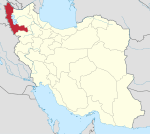Naqadeh
| Naqadeh نقده | |
|---|---|
| city | |
 Naqadeh | |
| Coordinates: 36°57′19″N 45°23′17″E / 36.95528°N 45.38806°ECoordinates: 36°57′19″N 45°23′17″E / 36.95528°N 45.38806°E | |
| Country |
|
| Province | West Azerbaijan |
| County | Naqadeh |
| Bakhsh mohammadyar | Central |
| Population (2006) | |
| • Total | 121,975 |
| Time zone | IRST (UTC+3:30) |
| • Summer (DST) | IRDT (UTC+4:30) |
Naqadeh, also known as Naghadeh, Naghdeh and Nagadeh (formerly known as Sulduz; also Romanized as Sulduz, Solduz and Suldoz),[1] is a city in and the capital of Naqadeh County, West Azerbaijan Province, Iran. At the 1996 census, its population was 110,257, in 20,781 families.
The city is located in the Gadar River valley, 23 kilometres (14 mi) south of Lake Urmia at an elevation of 1,300 metres (4,300 ft) above sea-level. The region's economy is based on agriculture, particularly the production of fruit, grain, and timber.
The town is inhabited mainly by Iranian Azerbaijanis, as well as some minorities of Kurds and Qarapapaqs, the latter whom were resettled from the Caucasus into the newly established borders of Persia/Iran after the loss of Georgia, Azerbaijan, Dagestan, and Armenia to neighboring Russia following the first and second Russo-Persian Wars of the (19th century). Until the genocides of World War One, the town was home to a large number of Assyrians who were massacered by Muslim Turks during the Assyrian Genocide.[2] The main religion of the area is Shia Islam, as with most of Iran.
Historical places
Naqadeh has several cultural and recreational attractions like "Yeddi göz" and "Sultan Yaghoob". The most important worth seeing and historical places of the city are as follows:
- Important archaeological sites in the vicinity of Naqadeh include Teppe Hasanlu, 12 kilometres (7.5 mi) northwest of Naqadeh and famous for its "Golden Cup", and Hajji Firuz where some of the oldest evidence for winemaking has been uncovered.
- Mannae and Urartu historical inscriptions in south-west to Lake Urmia.
- Several wetlands (Yadegarloo, Hassanlu and Sulduz wetlands).
- Zendan and Baha Hasan caves.
- tepe bashi- a square in the center of the city which is believed to have the arcaeological remains of a castle under it.
- Qal'a Paswe is a small village near Naqadeh whose name, according to the Iranist Vladimir Minorsky has existed since the 9th century BC and was built by the "Parsua tribes". I twas also mentioned in the records of the Assyrian ruler Shalmaneser III (reign 858-824 BC).[3]
Education
- Payam Noor University
- Azad University of Naghadeh
- Azad International University of Sulduz
Language
70 percent of the population of the city speak in Azerbaijani, the remaining amount predominantly speaks in Kurdish.[4]
Economy
The regional economy greatly depends on agricultural products, and cattle and sheep are raised both for meat and for wool. Some of this production is exported. The region's farmers also raise apples, grapes, tomatoes, potatoes, onions, peas, and other fruits. The high farm production results from the fertile soil and the use of modern machinery and scientific farming methods.
Notes
- ↑ Naqadeh can be found at GEOnet Names Server, at this link, by opening the Advanced Search box, entering "-3076454" in the "Unique Feature Id" form, and clicking on "Search Database".
- ↑ Familiar Faces in Unfamiliar Places:Assyrians in the California Heartland 1911 - 2010, Arianne Ishaya
- ↑ page 78 of Minorsky, V. (1957), "Mongol Place-Names in Mukri Kurdistan (Mongolica, 4)", Bulletin of the School of Oriental and African Studies, University of London, 19 (1): 58–81, doi:10.1017/s0041977x00119202, ISSN 0041-977X
- ↑ http://www.nagadeh-ag.ir/tabid/1375/Default.aspx?PageContentID=245
References
- اطلس گیتاشناسی استانهای ایران [Atlas Gitashenasi Ostanhai Iran] (Gitashenasi Province Atlas of Iran)
